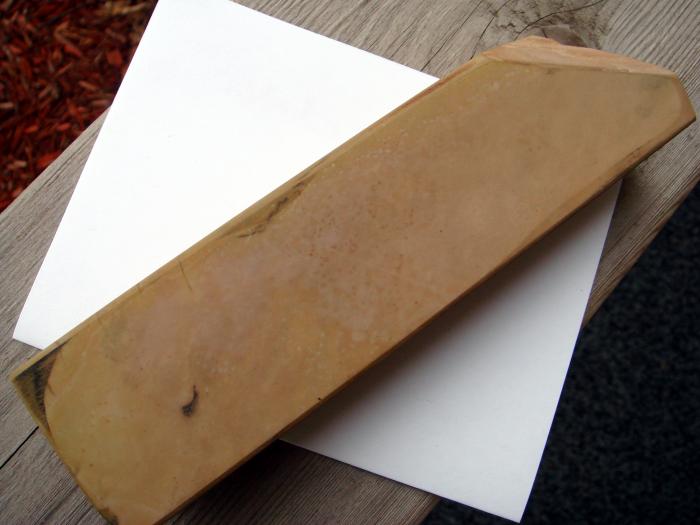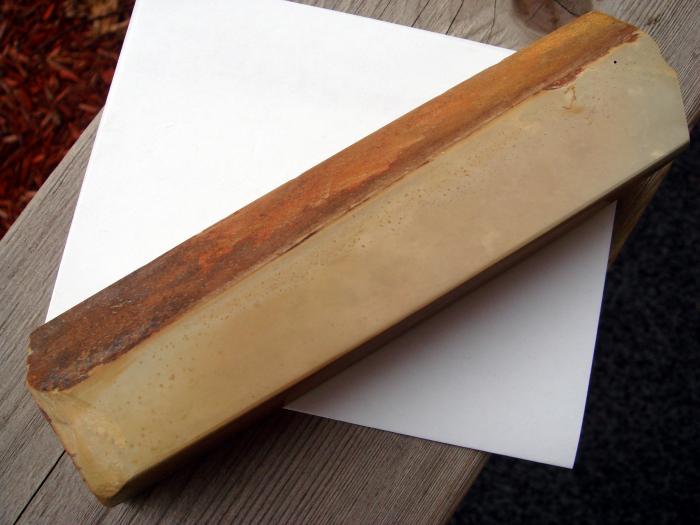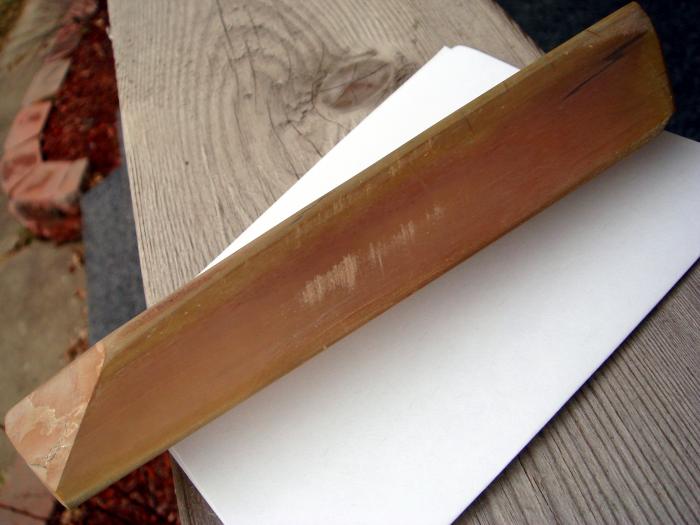Results 1 to 10 of 11
Thread: My Japanese Natural (pic heavy)
-
02-12-2009, 11:39 PM #1
 My Japanese Natural (pic heavy)
My Japanese Natural (pic heavy)
Here's some pics of my Japanese natural: Purchased from OLD_SCHOOL a few months ago.
Somebody PM'ed me asking whether the stone had different layers, and what the colors were etc.
Since I love this hone, and think it may have some broader interest to the community. Here are some pics!
I usually crop pics, but I left these as is in case someone wanted to mess with the color levels (as I do).



Edit, re-edit: pics fixed.Last edited by joke1176; 02-13-2009 at 02:11 AM. Reason: Removed Coticule pics as per request.
-
The Following 2 Users Say Thank You to joke1176 For This Useful Post:
FloorPizza (02-13-2009), hi_bud_gl (02-13-2009)
-
02-12-2009, 11:49 PM #2

There is a difference between the wide and narrow cutting surfaces. Aside from color, the narrow end is softer and creates slurry much faster. I would say it cuts a little bit faster as well, but that makes sense doesn't it?

Anyhoo, you can see the different layers, and I would bet they have different qualities, since the two exposed surfaces certainly do.
-
02-13-2009, 12:11 AM #3

Sometimes (and I don't know if this is your case) when they cut a rock if it was exposed to the elements it weathers and that outside surface looks very different than what's underneath, the underlying rock being the true material. Sometimes the rock is oxidized and or rotted and will have different characteristics depending on the makeup of the rock and what it was exposed to over time be it water, freezing, chemicals etc.
No matter how many men you kill you can't kill your successor-Emperor Nero
-
02-13-2009, 07:53 PM #4

Very nice pictures, thank you for sharing!
I only have a few natural stones so far, but a nice japanese natural definetly looks like a great addition to anyone's honing collection. Those pictures just made me want one even more!
-
02-13-2009, 10:31 PM #5
 lovely stone
lovely stone
excellent hone thank you for pictures.
-
02-14-2009, 12:48 AM #6
 Further Info on hone.
Further Info on hone.
Before I forget, this hone had every stamp on it but the Maruka "trademark" until I lapped them off.
Info from this post (http://straightrazorpalace.com/185523-post19.html).
Big thanks again to OLD_SCHOOL for posting all this stuff a while ago.
-
02-14-2009, 01:40 AM #7

your pics made me think of a couple of things. one was edited so i'm left with one thought.
you have more than one face lapped so it's not completely sealed. It may be something of a gamble, but i have rocks that are unsealed as well.
I reason that our use is a little different. In a shop, traditional use setting sharpening stones saw much more water, continual use without environmental control. Our work is much more gentle, and we can easily prevent extreme changes. So barring any superlative self cleaving skills i worry less than I used to about perfect sealing.
-
02-14-2009, 02:58 AM #8

I sealed mine (all sides except honing surface) with the ultra-thick
lacquer that O_S has available. It took ages to dry, and probably
wasn't necessary. I can't imagine regular honing circumstances that
would benefit from this kind of sealing, but it can't hurt.
- Scott
-
02-14-2009, 06:39 AM #9There is no charge for Awesomeness



- Join Date
- Aug 2006
- Location
- Maleny, Australia
- Posts
- 7,977
- Blog Entries
- 3
Thanked: 1587
Thanks for the photos! That looks like a lovely hone indeed.
James.<This signature intentionally left blank>
-
02-14-2009, 04:54 PM #10

I have 2 sides lapped, and was going to lap the side with the sawcut visible (pic 3), so I could have a THIRD lapped side, but it's dished out by about 1/32" or greater, and I left it alone.
The dark area visible in the third pic (top Right corner of hone) does absorb water faster than other surfaces of the hone, but I'm not worried about sealing it yet.
If it does cleave somewhere in the middle, I could potentially have 2 separate hones of useable thickness!
There are 3 darkened areas visible on the first pic:
The large triangular area in the first pic is from swarf, the little eyebrow shaped mark seen in the middle of the hone is in the stone itself, as is the darkened areas on the top edge.


 1Likes
1Likes LinkBack URL
LinkBack URL About LinkBacks
About LinkBacks






 Reply With Quote
Reply With Quote


